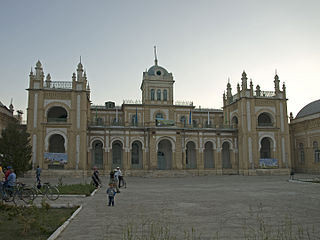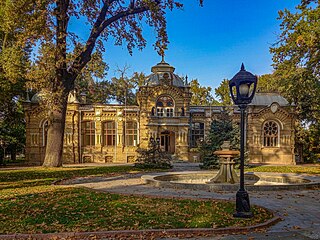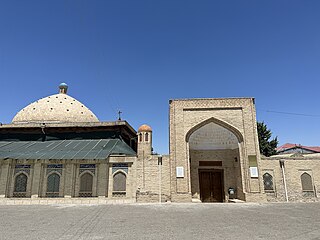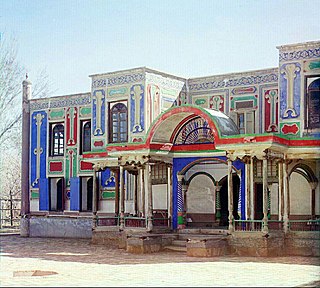
Qarshi is a city in southern Uzbekistan. It is the capital of Qashqadaryo Region. Administratively, Qarshi is a district-level city, that includes the urban-type settlement Qashqadaryo. It has a population of 278,300. It is about 520 km south-southwest of Tashkent, and about 335 km north of Uzbekistan's border with Afghanistan. It is located at latitude 38° 51' 48N; longitude 65° 47' 52E at an altitude of 374 meters. The city is important in natural gas production, but Qarshi is also famous for its production of woven flat carpets.

Bukhara is the seventh-largest city in Uzbekistan by population, with 280,187 residents as of 1 January 2020. It is the capital of Bukhara Region. The mother tongue of the majority of people of Bukhara is the Tajik dialect of the Persian language, although Uzbek is spoken as a second language by most residents.

Bukhara Region is a region of Uzbekistan located in the southwest of the country. The Kyzyl Kum desert takes up a large portion of its territory. It borders Turkmenistan, Navoiy Region, Qashqadaryo Region, a small part of the Xorazm Region, and the Karakalpakstan Republic. It covers an area of 40,216 km2. The population is estimated at 1,976,823 (2022), with 63% living in rural areas.

The Ark of Bukhara is a massive fortress located in the city of Bukhara, Uzbekistan, that was initially built and occupied around the 5th century AD. In addition to being a military structure, the Ark encompassed what was essentially a town that, during much of the fortress's history, was inhabited by the various royal courts that held sway over the region surrounding Bukhara. The Ark was used as a fortress until it fell to Russia in 1920. Currently, the Ark is a tourist attraction and houses museums covering its history. The museums and other restored areas include an archaeological museum, the throne room, the reception and coronation court, a local history museum, and the court mosque.

The Kalyan Minaret is a minaret of the Po-i-Kalyan mosque complex in Bukhara, Uzbekistan and one of the most prominent landmarks in the city.

Kogon is a district-level city in Bukhara Region in Uzbekistan. It is also the seat of Kogon District, but not part of it.

The memorial complex of Chor-Bakr was built over the burial place of Abu-Bakr-Said, who died in the year 360 of the Muslim Calendar, and who was one of the four of Abu-Bakrs (Chor-Bakr) – descendants of Muhammad. The complex includes the necropolis of family tombs, and courtyards enclosed with walls. It is located in modern-day Kalaya, Uzbekistan.

The Russian Museum of Ethnography is a museum in St. Petersburg that houses a collection of about 500,000 items relating to the ethnography, or cultural anthropology, of peoples of the former Russian Empire and the Soviet Union.

Chorsu, also called Charsu, in Samarkand, Uzbekistan, is a domed, hexagonal shape building with central big dome and six small domes around central dome. Chorsu located at southeast of the Registan at the intersection of the roads connecting Samarkand, Tashkent, Bukhara, and Shahrisabz. Chorsu is a word of Persian origin meaning "crossroads," referring to this intersection. The building is old, It has a rather rich centuries-old history. At the moment, it is included in the UNESCO World Heritage List along with the rest of the historical part of the city.

The Museum of Arts of Uzbekistan is the largest state art museum in Uzbekistan. Its permanent collection contains more than several thousands works, divided among four curatorial departments. The museum was established in 1918 as a Museum of People University and renamed as a Central Arts Museum later. It was named as Tashkent Art Museum in 1924 and finally Museum of Arts of Uzbekistan in 1935.

The State Museum of Applied Arts of Uzbekistan is an art museum located in Tashkent, Uzbekistan, founded in 1937 as a temporary exhibition for handicrafts. The museum contains over 4,000 exhibits on decorative art in Uzbekistan, including wood carving, ceramics, embossing, jewelry, gold weaving, embroidery, and samples of mass production in local industry.
Usta Shirin Murodov was a Soviet Uzbek master artist – a painter, pottery craftsman, and folklorist. He was an honorary member of the Academy of Sciences of Uzbekistan SSR (1943) and a distinguished artist recognized for his contributions to the art in the Uzbek SSR (1943). He was also the recipient of the First Degree Stalin Prize (1948).

The Romanov Palace, located in Tashkent, Uzbekistan, was built in 1891 according to the design of architect V.S Geintselman and A.L. Benois for Grand Duke Nikolai Konstantinovich, who had been exiled to the outskirts of the empire in the Turkestan region. The left wing of the palace housed the apartments of the Grand Duke, and the right-wing housed the apartments of his wife. Currently, the building is used as a reception house for the Ministry of Foreign Affairs of Uzbekistan. Near the entrance to the palace grounds, there used to be the Iosifo-Georgievskaya Church until 1995.

Nodir Devonbegi Khanqah is a historical monument in the city of Bukhara, Uzbekistan. It was built by Nodir devonbegi, who was the vizier and nephew of Imam Quli Khan, the ruler of the Bukhara Khanate, in the years 1620–1621. The khanqah, which is a type of building that served as a place of residence and worship for Sufi mystics, is included in the national register of immovable property objects of the material and cultural heritage of Uzbekistan.

The Bukhara Mosque is a historical monument in Bukhara. It is one of the mosques built for praying during Eid festivals. It was built behind the gate of the prayer hall in the southern part of Bukhara by Shams al-Mulk (1068-1080), who ruled Bukhara under the Kara-Khanid dynasty, in the 11th century. It was built in the 11th-16th centuries.

The Xalfa Xudoydod Complex is an architectural monument in Bukhara Region, Uzbekistan. The complex was built by Sheikh Xudoydod ibn Toshmuhammad Azizon al-Bukhari in 1777–1855, during the reign of the Manghit dynasty in Bukhara Emirate. The complex consists of a madrasa, a mosque, a house, a cistern and a cemetery.

Bukhara Prison is a fortified building that traditionally served as the prison of the Amir of Bukhara, in Uzbekistan. In the late 18th century, during the reign of the Mangits, it was built and was one of the largest prisons of the Bukhara Emirate. After the Bukhara Revolution, the collapse of the monarchy, and the formation of the Bukhara People's Soviet Republic, it was closed. Currently, it is considered one of the noteworthy places in the city. At the same time, the Museum of Legal and Judicial History of Bukhara is located here.

Shirbudun Palace is a palace complex in Bukhara, Uzbekistan, that served as one of the political centers of the Bukhara emirs. The construction of the palace began around 1870 during the rule of Muzaffar bin Nasrullah (1860–1885) in the Bukhara Emirate. In the 1870s, under the direction of the architect Abdurasul and the plasterer Rahim Hayotov, the palace complex, including the palace itself, a reception hall, a pool, a mosque, and other buildings, was built in Shirbudun. The external appearance of the palace reflects architectural features from Iran and Europe. During the reign of Emir Abd al-Ahad Khan, several palace chambers and elegant halls were added to the palace.

Ulugbek Madrasah is a memorial to Abdul Khaliq Ghijduwani, located in the city of Gijduvon in the Bukhara region of Uzbekistan. It is one of the ancient and renowned madrasas of Bukhara, also known as the "Fayziya Madrasah." Presently, it is also referred to as the Mirzo Ulugbek Madrasa. This prestigious educational institution was built in the Hijri year 836 beside the grave of Shaykh Abdul Khaliq Ghijduwani, with a two-story structure made of baked bricks. The Ulugbek Madrasah, established by Ulugh Beg, is the third and last madrasa he founded, relatively smaller and simpler compared to the Ulugbek Madrasah in Bukhara and Samarkand.

Ibrahim Akhund madrasah is a two-story madrasah located in the historical center of Bukhara city, Bukhara region, Republic of Uzbekistan. It is included in the national list of real estate objects of material and cultural heritage of Uzbekistan. The Varakhsha Archaeological Museum is in the building.



















